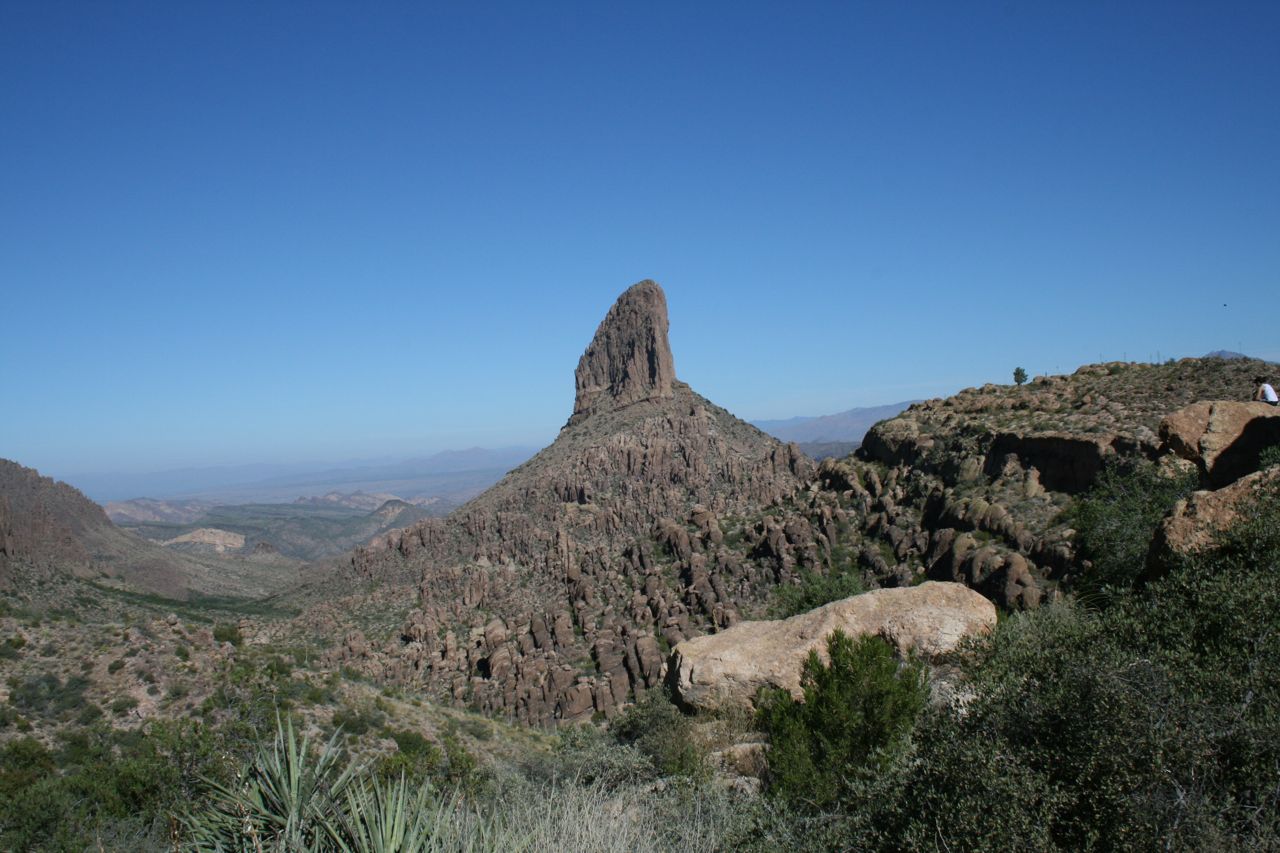 |
| Weaver's Needle Photo by Ihelewa |
The Lost Dutchman Mine is a legendary location that might be located outside of Phoenix, Arizona–in the Superstition Mountains. The mine is supposed to be chock full o' gold, but no one is sure of its precise location or if it truly exists. It is certain that a number of people have gone into the Superstitions and come out with a significant quantity of gold ore. It is also certain that a number of people have vanished in search of the mine or have been found dead after having gone to the mountain. More than that is speculation.
The first prospectors ever to go in search of the Lost Dutchman Mine were told of its existence by the local Apache Native American tribesman. The Apache seem to have known of gold in the mountains for a long time before white men came in search of it. However, the Apache believed that their Thunder God resided in the mountains and would punish anyone who looked for gold there, so they refused to tell anyone where the gold was located.
In 1540, Francisco Vasquez de Coronado came to Arizona from Mexico in search of the Seven Golden Cities of Cibola. The Apache told him of the gold in the Superstition Mountains, so he decided to look for it. He and a group of men went to the mountains in search of the gold but were waylaid by horrific tragedies. The men of the party kept vanishing, some were found dead with their heads removed from their bodies, while others simply disappeared. Those who survived would not venture near the mountains again. They never found the gold.
In 1845, Don Miguel Peralta left Mexico specifically to find the gold in the Superstitions. (At this time the Lost Dutchman Mine did not exist, even in legend.) He evidently found a very rich goldmine. He marked the location by carving his name into Weavers Needle and returned home for some mining supplies and workers. Soon after he returned to Arizona with his equipment and men, he began sending large quantities of gold home to Mexico.
Things did not turn out well for Miguel, despite his having apparently found the Lost Dutchman Mine. The Apache became restless because of the group’s presence in the mountains and so they planned to attack the mine. Peralta heard of this and closed the mine, hiding the entrance. The Apache killed him and all of his men as they attempted to leave the area. Their remains and the gold they had carried with them were reportedly found throughout the area for years to come.
Further evidence that there was gold in the mountains came in 1870, when an army doctor by the name of Abraham Thorne was brought to the mountain by a group of Apache who respected the help that the doctor had given them on their newly formed reservation. They blindfolded the man and brought him to a canyon where they removed the blindfold. The doctor said later that he found gold piled up there for him, but that he did not see a mine.
Not long after the Apache led the doctor to gold, the eponymous Dutchman came to the Superstition Mountains. The Dutchman was actually a German man by the name of Jacob Walz who came to the mountain in search of gold with his partner Jacob Weiser. Not long after the duo went to the mountain, they came out and began spending gold nuggets in Phoenix. There is much speculation regarding whether the men actually found their Lost Dutchman Mine, if they actually stole the gold or if they had found a hidden cache from the Peralta party. The speculation continues to this day.
During the following twenty years, Jacob Walz was seen spending gold nuggets intermittently, but always after a trip to the Superstitions. Jacob Weiser was not as lucky. At some point during those twenty years, he disappeared. There are many stories about what happened to the second Jacob, but the manner of his disappearance has never been proven. Waltz dropped hints about his having found a mine, but he never showed anyone the location. He claimed to have hidden it completely before his death in 1891. Following his death, the Dutchman and the Lost Dutchman Mine passed into legend.
Many people have gone in search of the Lost Dutchman Mine since that time, but to this day, no one has proven it exists. In fact, people seem to meet their doom rather than find gold when they go prospecting at the Superstition Mountains. A surprising number of people have been found in the mountains with fatal bullet wounds, but what is even worse is the number of people that have been decapitated there and the period of time over which the decapitations happened. These horrific deaths obviously lend to the mystery of the Lost Dutchman Mine because people still go to the Superstitions in search of gold to this day.